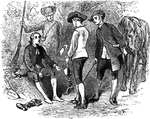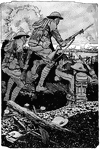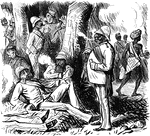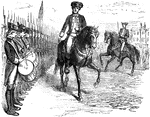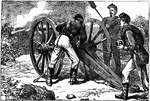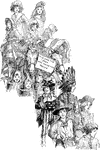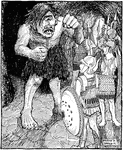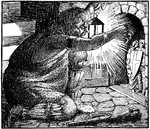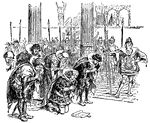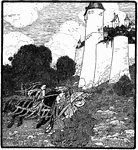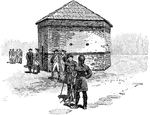
An 11th Century Norman Castle, Aerial View
Illustration of an aerial view of an 11th century Norman castle in Europe. From this view, it is possible…
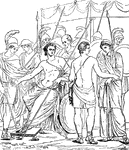
The Parting of Achilles and Briseis
"The Parting of Achilles and Briseis. (Supposed to be from a Greek Painting.)" —D'Anvers, 1895
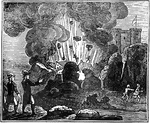
The Siege of Alicant
The Siege of Alicant, Spain in 1709. Caption bellow illustration: "The mine at last blew up; the rock…

Army of King Nebuchadnezzar
"In the thirteenth year of the reign of Nabuchodonosor, the two and twentieth day of the first month,…

Babylonia Poster
A poster of ancient Babylonia: Chaldea, Assyria, Persia, soldiers, religion, writing, and structures.
!["[African American] drivers of the baggage train attached to General Pleasonton's Cavalry brigade watering their mules in the Rappahannock. General Pleasonton's cavalry was attended by a very efficient forage brigade, consisting of mules and [African American] riders. Our sketch represents their drivers taking them to water at the river. The hard work these animals will endure is something wonderful, and justifies the high estimation in which they are held in the army." — Frank Leslie, 1896](https://etc.usf.edu/clipart/11000/11025/baggagetrain_11025_mth.gif)
Baggage Train
"[African American] drivers of the baggage train attached to General Pleasonton's Cavalry brigade watering…
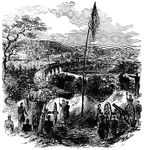
Bouquet Battery
"The Bouquet Battery, commanding the viaduct over the Patapsco River, on the Baltimore and Ohio Railroad,…

Duryea's Zouaves at Big Bethel Brining Off Grebel's Body
Group of soldiers escorting a corpse on a wagon.

Bird's Point
"View of the fortifications erected by the Federal troops at Bird's Point, MO., opposite Cairo, Ill."—…

Bivouac of the Eleventh Indiana Volunteers
Our special artist, who accompanied General McClellan's command, sketched the gallant Eleventh Indiana…

Blue Ridge Pass
"The victory at Blue Ridge Pass, Sunday, September 14th, 1862- infantry charge, and rout of the Confederates.…

Howard's Bridge and Mill
"Advance of the Federal troops, near Howard's Bridge and Mill, four miles from Big Bethel, on the road…

Commencement of Bull Run
"The Confederate forces under General Jackson advancing upon the Rapphannock Station at the river. Federal…

Castle Garden
"Reception of Brigadier General Corcoran by Mayor Opdyke and the citizens of New York, at Castle Garden,…

Castle Thunder, Richmond, VA, Where Union Prisoners Were Confined
Castle Thunder, one of the Confederate prisons known for its abominable conditions.

Stuart's Cavalry
"Stuart's Confederate Cavalry, after their successful raid into Pennsylvania, escaping with their stolen…

Battle of Cedar Mountain
"Battle of Cedar Mountain, fought Saturday, August 9th, 1862, between the Federal troops commanded by…

Men in Chariot Pulled by Goats
An illustration of two men standing in a chariot pulled by two small goats.

Battle of Charles City
"Battle of Charles City Road- charge of the Jersey Brigade- the first New Jersey brigade, General Tayler,…

Valley of Chickahominy
"Valley of the Chickahominy, looking southeast from the vicinity of Mechanicsville, the scene of the…
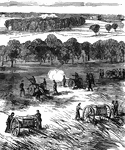
Valley of Chickahominy
"Valley of the Chickahominy, looking southeast from the vicinity of Mechanicsville, the scene of the…
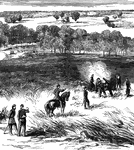
Valley of Chickahominy
"Valley of the Chickahominy, looking southeast from the vicinity of Mechanicsville, the scene of the…
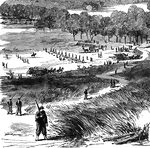
Valley of Chickahominy
"Valley of the Chickahominy, looking southeast from the vicinity of Mechanicsville, the scene of the…
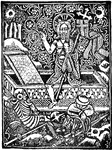
Leiden Christi
Leiden Christi is a drawing that was printed by German artist Albrecht Pfister in 1470. It depicts Jesus…

Confederate Fortifications
"Interior of the principal Confederate fortifications near New Berne, N. C., after their capture by…

Conrad's Ferry
"Conrad's Ferry, Md., above Harrison's Island, on the Potomac River, the place of passage of Colonel…

Battle of Cross Keys
"Battle of Cross Keys, Sunday June 8th, 1862- centre and front of the Federal army in the engagement.…
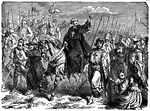
The Crusades being Preached by a Monk on Horseback
Illustration of a monk, riding horseback, surrounded by other Crusaders. Two other monks are in the…
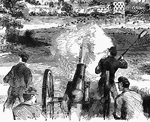
Battle at Dam No. 4
"Battle at Dam No. 4, Potomac River, between Butterfield's brigade and a large Confederate force. A…
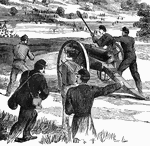
Battle at Dam No. 4
"Battle at Dam No. 4, Potomac River, between Butterfield's brigade and a large Confederate force. A…

Battle at Dam No. 4
"Battle at Dam No. 4, Potomac River, between Butterfield's brigade and a large Confederate force. A…
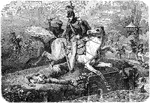
The Death of Poniatowski
"The Death of Poniatowski. From the painting by Horace Vernet." -Rees, 1894
!["A detachment of the First South Carolina [African American] Federal Volunteers, under the command of Colonel Beard, repelling the attack of Confederate troops in the vicinity of Doboy River, GA." —Leslie, 1896](https://etc.usf.edu/clipart/11200/11251/doboy_11251_mth.gif)
Doboy River
"A detachment of the First South Carolina [African American] Federal Volunteers, under the command of…

The Draft Riots in New York - The Battle in Second Avenue
Rioting in New York City after passage of an unpopular draft.

Edward's Ferry
"Successful retreat of the Federal troops from the Virginia shore across a canal-boat bridge at Edward's…
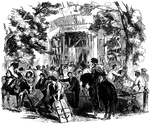
Adams Express
"Scene in Adams Express office, at Fortress Monroe, VA., in 1861- Volunteers receiving letters and packages…

Review of Federal Army
"President Lincoln, attended by General McClellan and staff, reviewing the Federal army, on Tuesday,…

Federal Kitchen
"The Federal Kitchen on the march to Fredericksburg with three days' rations." — Frank Leslie,…
!["First and last review of the First Regiment, South Carolina [African American] Volunteers, on Hilton Head, S. C., under Colonel Fessenden, U. S. A., June 25th, 1862. Our correspondent at Hilton Head wrote us: "I witnessed the parade entire, as well as the company drills in the manual of arms, etc., afterward, and I must acknowledge my complete surprise at the discipline and even vim evinced by the sable crowd. Dressed in the regulation uniform of the United States Army, tall and strong men generally speaking, they, considering that the regiment had not been fully armed but about ten days, spoke well for officers and men."" — Frank Leslie, 1896](https://etc.usf.edu/clipart/11000/11043/1stregiment_11043_mth.gif)
First Regiment
"First and last review of the First Regiment, South Carolina [African American] Volunteers, on Hilton…
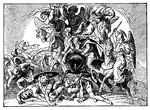
Five Angelic Warriors Fight for the Maccabees
Illustration of the Maccabee warriors fighting alongside angelic warriors in a swirl of battle. The…
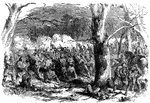
Storming of Fort Donelson
"Storming of Fort Donelson- decisive bayonet charge of the Iowa Second Regiment on the Confederate intrenchments…

Fort Macon
"Surrender of Fort Macon, GA., April 26th, 1862- lowering the Confederate flag."— Frank Leslie,…

